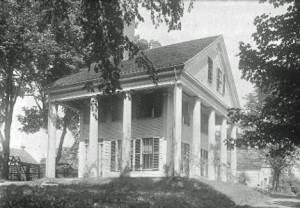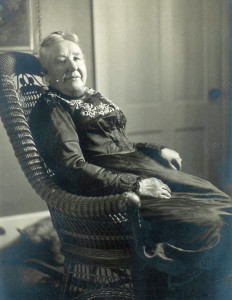Hospital on a Hill
By George T. ComeauThere is no doubt that great fanfare accompanied the crowd that showed up for the opening of the Canton Hospital on that cold day in December 1916. It was, like all things, a labor of love that took over 16 years of vision and planning to come to fruition. And there is no doubt that the needs of the community 100 years ago were far different than they are today.

The Marcus Clark House on High Street was also the Canton Hospital from 1916 to 1921. (Courtesy of the Canton Historical Society)
The Canton District Nursing Association was organized just at the beginning of the last century. Only one nurse was employed for the first 15 years of its service. By 1915, a large “welfare house” had opened on Rockland Street, which precipitated the hiring of a second nurse. By then, Canton was burgeoning under an influx of immigrants who came to work in the factories and mills that were humming all throughout the town.
In fact, it was the factories of the town that caused the most heinous injuries imaginable. Case after case of disfigurement was logged in the local paper week after week. And the young immigrants bore the greatest losses. In one case, Antonio Mirandi, a Portuguese boy of 19, was drawn into a grinder at Plymouth Rubber and was mutilated such that he would lose both arms that day. It took 20 minutes to disassemble the machine that had drawn Mirandi into its one-ton rollers. Dr. Luce was summoned to the factory to attend to the boy and stem the flow of blood. An ambulance was called, and Mirandi was taken to the closest hospital — at Corey Hill in Brookline, some 25 miles away. Large amounts of blood were lost and it is indeed a minor miracle that Mirandi survived.
It wasn’t only the men who suffered grave injuries. In October of that same year, a 28-year-old nurse from the Massachusetts Hospital School by the name of Emily Mae Kefford was killed in a freak trolley accident at Washington and Randolph streets. Kefford had no family here and had come from Cambridge, England to serve the children of the Hospital School. As she was running to catch the trolley, she ran in front of the wheels, hoping to board the moving car from the front, but she misjudged the speed, severing both legs. The young nurse was taken to the Hospital School and died there within 25 hours. Kefford’s final words were, “I guess I didn’t get clear across the track.” Without a family, the doctors and nurses collected enough money to bury the young woman and place a headstone at her grave in Canton Corner.
Each week, and year after year, there were cases of the most terrible sort. And Canton had little medical care that could address an acute injury. The need was great and it was the women of the town who came together to meet it. Interestingly, the women, mostly socialites, were married to the very men who owned the factories in which the most critical cases were sourced. Mrs. George Frederick Sumner, Mrs. Martha Howard Draper, Mrs. Charles French, Mrs. Joseph Hatfield, and Annie Sumner were among the women who founded the nursing association. And they had big plans.
They would go on to build a large and spacious “modern” hospital. The demand for it was evident — in the preceding 10 months before the hospital opened, the two nurses in Canton attended to 161 patients at the Welfare House. Sixty-five of these patients underwent surgical operations. At the same time, the nurses made almost 250 home visits. All in all, more than 400 residents were treated in any given year.
One of the key elements of the success of the Canton Nurses Association was the fact that its founders were all married to the captains of Canton’s industry and thus had enormous sums of money to pledge for the realization of the new hospital. They had the means and the support to do great things, and they met the challenge head on.

Mrs. George F. Sumner was the president of the Canton Nursing Hospital. (Courtesy of the Canton Historical Society)
You can still see the building in much the same setting as it was that December day in 1916. As you travel up High Street, well before the crest of the hill is a large house with white pillars. It was described as “situated on a high knoll in the most elevated part of the town, and commands a magnificent view of the country. The quietness of the locality and the beauty of its surroundings make it an ideal spot for the purpose for which it was chosen.” This magnificent building sat on 12 acres of land and also included a large barn and several outbuildings. The design was called “old colonial,” but in reality it would be called Greek Revival by architectural historians.
The house was originally constructed for Marcus Clark in 1851 and built by a New York contractor by the name of Francis Batchelder. It changed hands at least once before being sold to Cordelia Litchfield of the Canton Nursing Association in 1916. That same year a spacious ward was laid out with five beds in what was a front parlor. If need be, the space could hold up to seven beds in an emergency. On the second floor, two bedrooms were converted to private patient rooms, and a small operating room was situated on the western side of the second floor. A large sterilizer was purchased and had a special room devoted to its care and use. The third floor became a space for a dormitory for the nurses.
The success of the Canton Nurses Association embodied in the hospital meant that they could work in a clean and fitting environment and extend their services to even more patients. Earlier that same year, the nurses, “in line with the aggressive and up to date spirit,” opened a dental clinic. In eight short months 152 children were provided with modern dental treatments. The community readily accepted and favored the new institution. Under the rules, patients were allowed the use of the hospital while under the care of their own physician. The hospital was funded through payments for stays, and the town of Canton appropriated $1,000 for the salary of the district nurses.
And, as has always been the case in nonprofit organizations, private donations amounted to almost 30 percent of the total operating costs. That said, it was an expensive venture. By the time the hospital opened, the association employed a full-time superintendent and four nurses. It was a critical decision to open this hospital. By 1918 a strain of influenza struck and a tremendous number of cases were handled heroically at this hospital. By 1921 Norwood Hospital had developed sufficiently enough to obviate the need for the small rural beds in Canton. The nursing association moved onto other missions in Canton and the building was sold and returned to use as a private residence. Today it sits as a reminder to the dedication of the women of Canton and our earliest major health care initiative.
Short URL: https://www.thecantoncitizen.com/?p=35149










